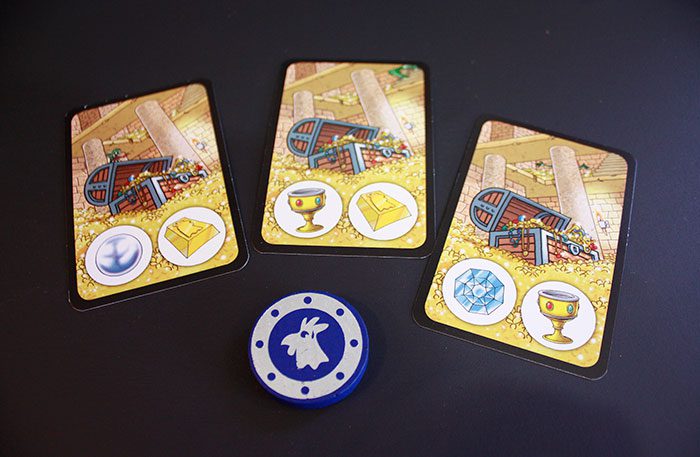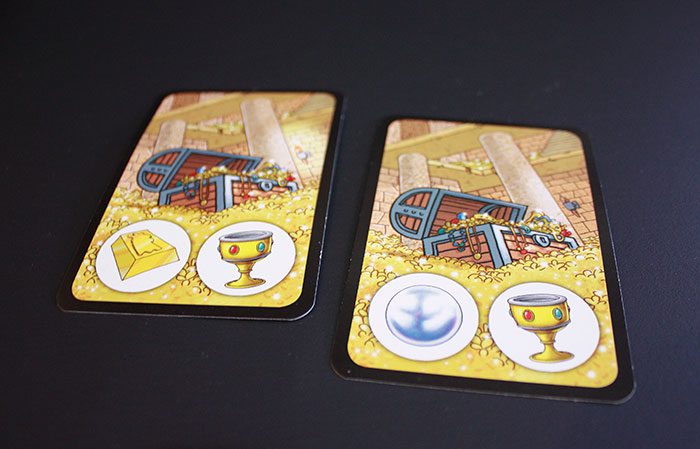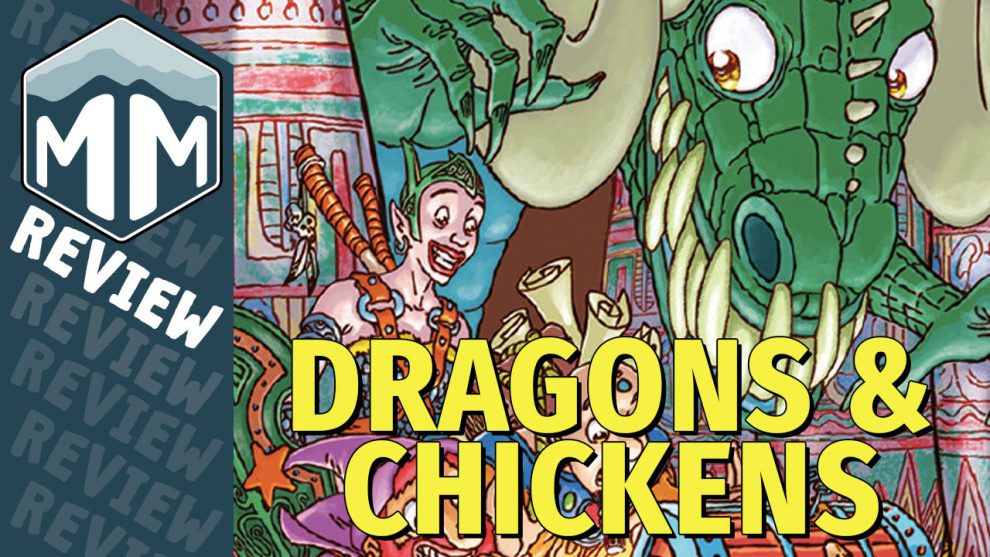Overview
Devir’s fast-paced card game ‘Dragons & Chickens’ requires luck, speed and a sense of humor as players race to accumulate treasure cards while avoiding a sneaky beast intent on hoarding riches.
The quickest thieves will be rewarded as they grab for golden goblets and rare gemstones while keeping a wary eye out for danger.
And where do the chickens come into play? Well, every skilled thief knows that a lonely dragon craves companionship (and/or a feathery meal) from time to time…
Game Play
Description:
“You have just entered the dungeon in search of great treasures. Inside you will find riches, but also a terrible dragon who’s not so keen on letting you take them… The life of an adventurer is hard, but sometimes the profits make up for it.” — from the English ruleset
Contents:
110 Cards, 1 wooden treasure chest and 1 wooden shield disc
Set Up:
Set up is relatively quick and simple.
- Remove the double-sided dragon card from the deck and set it aside (this card does not have to be within reach).
- Shuffle the remaining 109 cards and divide them evenly among the number of players (any extra cards should be returned to the box). These cards should be arranged in a face down draw pile in front of each participant.
- Place the wooden shield and treasure chest in the center of all participating players.
- You are ready to begin.

How to Play:
Players compete over a series of rounds to collect and keep treasure cards.
At the start of each round every participant states “My treasure” while simultaneously turning over the top card in their individual deck so that it can be clearly seen by everybody participating in the game.
Each face-up card will depict a treasure room containing either a chicken or two different images of treasure (ring, pearl, crown, gold bar, diamond, or chalice).
The first player to accurately identify and call out the most abundant treasure symbol depicted on the face-up cards wins the round. However, when two or more treasure images are tied the first player to grab the wooden treasure chest will win the face-up cards.
But beware, lest you spot a sneaky dragon lurking amongst his cache. Only the fastest players will be saved from the dragon’s fiery wrath by quickly stacking their hand on top of the wooden shield piece. The last player to add their hand to the stack will be caught by the dragon and must forfeit any cards they have collected that feature either of the symbols depicted on the dragon card.

But what about the chickens?! Before giving up any treasure, a player caught by the dragon should first check their prize cards to see if they have captured any chickens. A player who has been caught by the dragon may sacrifice a chicken card in lieu of giving up their hard-earned treasure.
And finally be on the lookout for darkened treasure rooms. A player who notices a room with an unlit torch may steal that card at any point during the round, regardless of dragons or matching treasure symbols.
End of the Game
The game ends when the final round of cards have been turned face-up and claimed by either players or the dragon.
Determining a Winner
The victor will be the thief with the most treasure cards at the end of the game.
Final Thoughts
Dragons & Chickens is a simple, but fast paced, card game requiring minimal skill to master, perhaps best suited for casual social occasions among well-matched players.
Thieves with nimble fingers and quick reflexes will nab the victory, while slower players are left to face the dragon’s wrath, which can become frustrating when speed or comprehension isn’t evenly matched across all participants.
Thankfully the quirky illustrations and whimsical aspects of this game serve to remind players that Dragons & Chickens is not meant to be taken too seriously.

What I dislike about Dragons & Chickens:
I have to admit that the biggest issue I have with this game rests with the rulebook which features a few small grammatical mistakes and is set in a clunky medieval typeface that is, at times, frustrating to read.
I must also point out that, while Dragons & Chickens is a relatively simple game to understand, the rulebook seems to overly complicate some aspects of play while leaving other issues completely unaddressed. For example: what should be done in the situation where every treasure symbol exposed in a round is unique (which often happens in a game with fewer players)? Would this situation be considered a tie and require players to grab for the wooden treasure chest? Or should players turn over additional cards until more symbols are exposed? Because of this confusing rule issue I would not recommend Dragons & Chickens as a 2 player game.
Although Dragons & Chickens is fun to play among several evenly-matched participants, this game can easily become frustrating for players who may not have the speed, dexterity or ruthlessness that this game requires to win. Therefore, as a parent, I find that the age recommendation may not be completely accurate on this game.
What I like about Dragons & Chickens:
The illustrations are cleverly drawn so that cards containing dragons and unlit torches can easily be overlooked, which can lead to competitive (and often hilarious) scrambling for cards and/or the safety of the wooden shield.
An undetected dragon can easily change the tide of play for a thief who doesn’t have a chicken to sacrifice, upsetting the scales in favor of a more cautious player.
The simplicity of this game lends itself to many creative rule adaptations… For example: we sometimes enjoy playing that if the greedy reptile finishes the game with more treasure cards than the most proficient thief, then the dragon is declared the winner.
This game can be quite fun when played with several people at once (4 or 5 players is best), but is simple and quick enough to still allow for a very social atmosphere.
In short, if you’re looking for a lighthearted game with minimal strategy requirements then Dragons & Chickens just might be for you.
What do you think about Dragons & Chickens? Give us your opinions about what you like and/or dislike about the game in the comments below!







